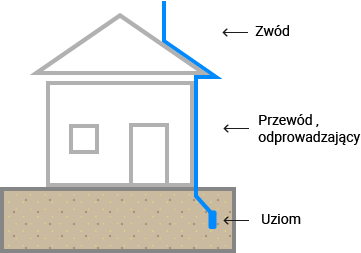Instalacje odgromowe i zabezpieczenia nadprądowe
Instalacja odgromowa jest systemem zabezpieczającym budynek przed groźnymi skutkami wyładowań atmosferycznych (piorunowych). Pierwszy piorunochron zainstalowany został w roku 1752 przez Benjamina Franklina w Filadelfii.
Skąd się bierze piorun
Krople wody i drobiny lodu znajdujące się w chmurze burzowej ocierają się o siebie generując ładunek elektryczny (lód przekazuje elektrony wodzie). Gdy ładunek jest wystarczająco duży (a więc różnica potencjałów między szczytem chmury i ziemią jest wystarczająca) następuje wyładowanie elektrostatyczne. Podczas uderzenia pioruna wyzwalana jest ogromna ilość energii, która może być bardzo niebezpieczna, zarówno dla instalacji elektrycznych (wszystkich urządzeń podłączonych do instalacji), jak i ludzkiego życia.
Zasada działania instalacji odgromowej
Zasada działania instalacji odgromowej polega na przechwytywaniu wyładowań przez zwody i, poprzez resztę instalacji, bezpiecznym przekazywaniu ich do ziemi. Zwód wykonany jest z metalu – najczęściej aluminium, miedzi lub stali nierdzewnej – dzięki czemu piorun uderza właśnie w niego (rezystancja metalu jest niższa od rezystancji powietrza). Typowa instalacja odgromowa składa się ze:
- zwodów – elementów przyjmujących wyładowania elektrostatyczne o wysokim natężeniu (rzędu kiloamperów), które można podzielić na zwody naturalne (np. maszty anten, zbrojenia żelbetowe i inne elementy „naturalnie” wystające poza dach) oraz sztuczne (pręty pionowe lub instalacje otokowe)
- przewodów odprowadzających – elementów łączących zwody z uziomem
- uziomów – elementów rozpraszających energię wyładowania do ziemi
Ochronniki przeciwprzepięciowe
W przypadku wyładowania w bliskim sąsiedztwie domu, instalacja odgromowa może nie być wystarczająca. W takim przypadku prądy przenikające do sieci mogą zrujnować urządzenia połączone z instalacją. Aby uchronić się przed skutkami takich sytuacji zastosować należy ochronę przeciwprzepięciową – zastosować ochronniki oraz połączenia wyrównawcze.
Ochronnik jest elementem instalacji służącym do odprowadzenia prądu przepięcia do uziomu zabezpieczając tym samym urządzenia podłączone do sieci przed skutkami owych przepięć. Ochronniki dzielą się na trzy klasy oznaczone rzymskimi cyframi:
- klasa I – oznaczane także jako B – ochronniki umieszczane w złączu budynku
- klasa II – oznaczane także jako C – ochronniki umieszczane w rozdzielnicy
- klasa III – oznaczane także jako D – ochronniki umieszczane bezpośrednio przy urządzeniu
W niektórych przypadkach (najczęściej w domach jednorodzinnych) stosuje się ograniczniki klasy I+II (B+C), które zajmują mniej miejsca w rozdzielnicy i nie wymagają stosowania dodatkowych dławików odprzęgających.
Praktyczną może okazać się wiedza dotycząca zabezpieczeń, jednak każdorazowo budowę instalacji należy zlecić fachowcom posiadającym uprawnienia i przestrzegającym norm.



